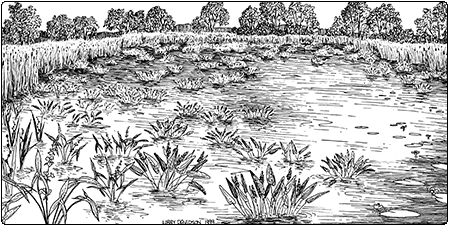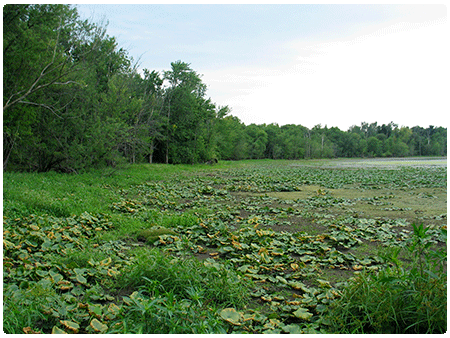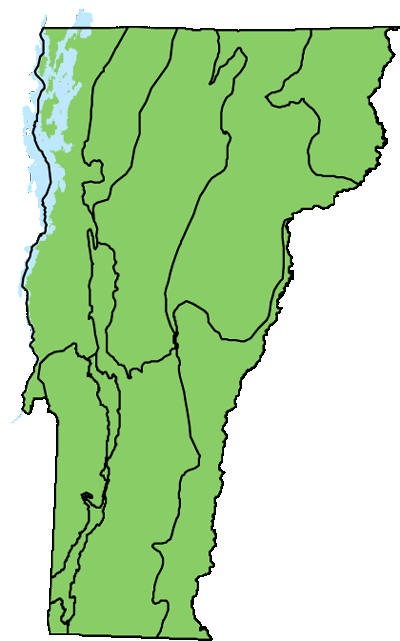Ecology and Physical Setting 
Deep Broadleaf Marsh is a common community type found throughout Vermont on the sheltered margins of lakes and ponds, on the slow-moving backwaters of larger rivers, and in isolated basins. The purplish-blue flowers of pickerelweed add a splash of color to these marshes in mid-summer. Deep Broadleaf Marshes are typically inundated by six inches to three feet of water throughout the growing season, although the substrate may become exposed by late summer in drier years. The soils are derived from rich, well-decomposed organic material that settles out from the marsh and adjacent open water. In marshes with stagnant or very slowly moving water, this organic material may form loose, flocculent suspensions that settle below the water surface, creating a false bottom that conceals a deeper water column.
 Towards deeper water, Deep Broadleaf Marshes commonly grade into Deep Bulrush Marshes on open lakeshores and into floating-leaved aquatic communities in more sheltered ponds. On the shallower side, Deep Broadleaf Marshes may grade into Cattail Marshes. In many cases, however, vegetation zonation in deepwater marshes is not this orderly, and several communities intergrade to form a rich wetland mosaic.
Towards deeper water, Deep Broadleaf Marshes commonly grade into Deep Bulrush Marshes on open lakeshores and into floating-leaved aquatic communities in more sheltered ponds. On the shallower side, Deep Broadleaf Marshes may grade into Cattail Marshes. In many cases, however, vegetation zonation in deepwater marshes is not this orderly, and several communities intergrade to form a rich wetland mosaic.
Vegetation
This community is broadly defined, and there can be considerable variability in the dominant vegetation present from one marsh to another. It is common for a single species to dominate in clonal patches of various sizes. Competition plays an important role in which plants grow where. Once a clone becomes established it excludes most other plants. The most common clone-forming species are pickerelweed, broad-leaved arrowhead, and giant bur-reed. Other plants that may be abundant include marsh spikerush and water horsetail.
Wildlife Habitat
Deep Broadleaf Marshes provide important feeding habitat and brood cover for several species of ducks, including wood duck, mallard, and black duck. Lake Champlain and the Connecticut River are important migratory corridors for waterfowl—many of which nest to our north and winter to our south. Vermont’s large marsh complexes provide especially important stopovers for resting and feeding. Some of these migratory species include American wigeon, gadwall, northern pintail, greater and lesser scaups, common goldeneye, ring-necked duck, and northern shoveler. Rare marsh birds that may breed in Deep Broadleaf Marshes include pied-billed grebe and common gallinule.
Common watersnakes hunt for fish and frogs in these marshes. Painted turtles and snapping turtles are both common in these marshes—painted turtles may be observed basking on logs or vegetation hummocks. The rare spiny softshell and eastern musk turtle—both primarily aquatic species—feed on small aquatic invertebrates and tadpoles on the muddy bottoms of deep marshes.
Mink and muskrat can be abundant in Deep Broadleaf Marshes. Moose are excellent swimmers and may be seen in deep marshes of northern lakes feeding on aquatic vegetation and escaping heat and biting insects during summer months.
Two small bee species are dependent on pickerelweed for pollen. One, pickerelweed bee, swarms around flowering pickerelweed in some Vermont marshes. The other, Melissodes apicata, is known from New Hampshire and New York and is expected to occur in Vermont as well.
Related Communities
- Deep Bulrush Marsh may occur adjacent to and intergrade with Deep Broadleaf Marsh. It is typically exposed to wave action and is dominated by bulrushes.
- Cattail Marsh: Common cattail is the dominant plant in these marshes, often to the exclusion of many other species. Cattail Marshes typically have shallower water and dry up more frequently than Deep Broadleaf Marshes.
- Shallow Emergent Marsh has saturated soils or only seasonal inundation. It is highly variable in species composition but is dominated by species like blue-joint grass, Joe-Pye weed, woolgrass, and blue vervain.
Conservation Status and Management Considerations
This community is commonly associated with open water and is usually somewhat buffered from adjacent upland disturbances by the presence of other wetland types that occur landward, such as Cattail Marshes and shrub swamps. Agricultural and stormwater runoff are a distinct threat to the integrity of this community and the wetland and aquatic systems with which it occurs. Another significant threat to Deep Broadleaf Marshes is the spread of non-native invasive species such as water chestnut, a Eurasian plant that colonizes deep marshes and excludes native species.
Distribution/Abundance 
Deep Broadleaf Marshes occur throughout Vermont, however, the largest examples are found in the lowlands, especially adjacent to Lake Champlain, Lake Memphremagog, and in the Connecticut River Valley. Similar communities occur throughout eastern North America.
Characteristic Plants
Herbs
Abundant Species
Pickerelweed – Pontederia cordata
Broad-leaved arrowhead – Sagittaria latifolia
Giant bur-reed – Sparganium eurycarpum
Occasional to Locally Abundant Species
Marsh spikerush – Eleocharis palustris
Water horsetail – Equisetum fluviatile
Water willow – Decodon verticillatus
Sessile-fruited arrowhead – Sagittaria rigida
American bur-reed – Sparganium americanum
Soft-stem bulrush – Schoenoplectus tabernaemontani
River bulrush – Bolboschoenus fluviatilis
Yellow waterlily – Nuphar variegata
White waterlily – Nymphaea odorata
Common coontail – Ceratophyllum demersum
Common bladderwort – Utricularia macrorhiza
Common duckweed – Lemna minor
Water smartweed – Persicaria amphibia
Floating pondweed – Potamogeton natans
Non-native Invasive Plants
Water chestnut – Trapa natans
Flowering rush – Butomus umbellatus
Frog’s-bit – Hydrocharis morsus-ranae
Rare and Uncommon Plants
Arrow arum – Peltandra virginica
Lake-cress – Rorippa aquatica
Least bur-reed – Sparganium natans
Dwarf water-lily – Nymphaea leibergii
Branched bur-reed – Sparganium androcladum
Mare’s tail – Hippuris vulgaris
Associated Animals
Northern leopard frog – Lithobates pipiens
American bullfrog – Lithobates catesbeianus
Green frog – Lithobates clamitans
Snapping turtle – Chelydra serpentina
Painted turtle – Chrysemys picta
Muskrat – Ondatra zibethicus
Mink – Neovison vison
Moose – Alces americanus
Wood duck – Aix sponsa
Mallard – Anas platyrhynchos
Great blue heron – Ardea herodias
Lance-tipped darner – Aeshna constricta
Belted whiteface – Leucorrhinia proxima
Slender spreadwing – Lestes rectangularis
Pickerelweed bee – Dufourea novaeangliae
Rare and Uncommon Animals
Common watersnake – Nerodia sipedon
Spiny softshell – Apalone spinifera
Eastern musk turtle – Sternotherus odoratus
American black duck – Anas rubripes
Pied-billed grebe – Podilymbus podiceps
Common gallinule – Gallinula galeata
Places to Visit
Missisquoi National Wildlife Refuge, Swanton and Highgate, U.S. Fish and Wildlife Service
South Bay Wildlife Management Area, Coventry, Vermont Fish and Wildlife Department (VFWD)
Shelburne Pond Natural Area, Shelburne, University of Vermont and The Nature Conservancy (TNC)
East Creek Natural Area (TNC) and East Creek Wildlife Management Area, Orwell, VFWD
Lower Otter Creek Wildlife Management Area, Ferrisburgh, VFWD
Lake Bomoseen marshes, Hubbardton
